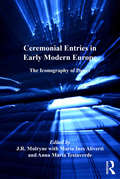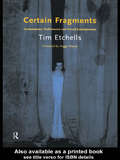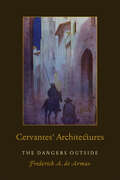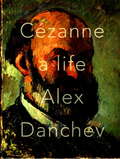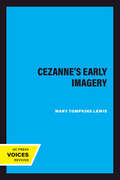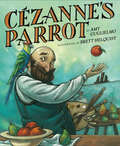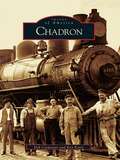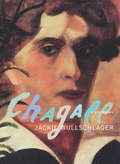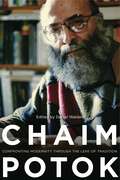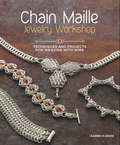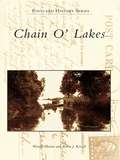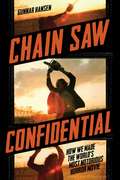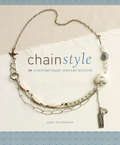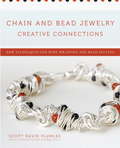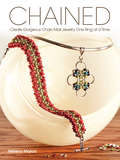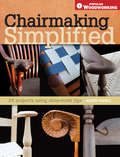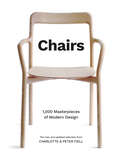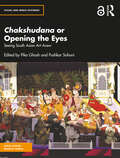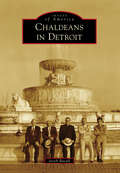- Table View
- List View
Ceremonial Entries in Early Modern Europe: The Iconography of Power (European Festival Studies: 1450-1700)
by J. R. Mulryne Maria Ines Aliverti Anna Maria TestaverdeThe fourteen essays that comprise this volume concentrate on festival iconography, the visual and written languages, including ephemeral and permanent structures, costume, dramatic performance, inscriptions and published festival books that ’voiced’ the social, political and cultural messages incorporated in processional entries in the countries of early modern Europe. The volume also includes a transcript of the newly-discovered Register of Lionardo di Zanobi Bartholini, a Florentine merchant, which sets out in detail the expenses for each worker for the possesso (or Entry) of Pope Leo X to Rome in April 1513.
Ceres
by Jeff BenzigerFertile soil drew Ceres founder Daniel Whitmore to the flat land south of the Tuolumne River in California's San Joaquin Valley in 1867. Named for the Roman goddess of agriculture, Ceres was laid out in 1875 among the stalks of grain. A devout Baptist, Whitmore offered free lots to anyone who wanted to make Ceres their home with a pledge never to use alcohol. As irrigation water and railroad tracks were later introduced, the town flourished as an agricultural community where peaches, almonds, and walnuts are grown. Today Ceres has retained its agricultural roots, and drinking is now permissible. In fact, one of the nation's largest wine producers, Bronco Winery, calls Ceres home. Residents come together as a community with the Ceres Street Faire, summer Concerts in the Park, Farmers Market and the dazzling Christmas Tree Lane.
Certain Fragments: Texts and Writings on Performance
by Tim EtchellsWhat is the relationship between performance and play? Between performance and technology? Between performance and death? Certain Fragments is an extraordinary exploration of what lies at the heart of contemporary theatre. Written by the artistic director of Forced Entertainment, acknowledged to be Britains most brilliant experimental theatre company (Guardian), Certain Fragments investigates the processes of devising performance, the role of writing in an interdisciplinary theatre, and the influence of the city on contemporary art practice. Tim Etchells unique and provocative voice shifts from intimate anecdote to critical analysis and back again. And as in his theatre-making so in his book: with Certain Fragments Etchells disrupts traditional notions of creative, academic, and intellectual work. The book is an exciting and radical fusion of story-telling and criticism. It also makes available, for the first time, four seminal Forced Entertainment texts by Etchells.
Cervantes’ Architectures: The Dangers Outside (Toronto Iberic)
by Frederick A. de ArmasCervantes’ Architectures is the first book dedicated to architecture in Cervantes’ prose fiction. At a time when a pandemic is sweeping the world, this book reflects on the danger outside by concentrating on the role of enclosed structures as places where humans may feel safe, or as sites of beauty and harmony that provide solace. At the same time, a number of the architectures in Cervantes trigger dread and claustrophobia as they display a kind of shapelessness and a haunting aura that blends with the narrative. This volume invites readers to discover hundreds of edifices that Cervantes built with the pen. Their variety is astounding. The narrators and characters in these novels tell of castles, fortifications, inns, mills, prisons, palaces, towers, and villas which appear in their routes or in their conversations, and which welcome them, amaze them, or entrap them. Cervantes may describe actual buildings such as the Pantheon in Rome, or he may imagine structures that metamorphose before our eyes, as we come to view one architecture within another, and within another, creating an abyss of space. They deeply affect the characters as they feel enclosed, liberated, or suspended or as they look upon such structures with dread, relief, or admiration. Cervantes' Architectures sheds light on how places and spaces are perceived through words and how impossible structures find support, paradoxically, in the literary architecture of the work.
Cezanne
by Alex DanchevAlex Danchev gives us the first comprehensive assessment of the revolutionary work and restless life of Paul Cézanne to be published in decades. One of the most influential painters of his time and beyond, Cézanne was the exemplary artist-creator of the modern age who changed the way we see the world. With brisk intellect, rich documentation, and eighty-eight color and fifty-two black-and-white illustrations, Danchev tells the story of an artist who was originally considered a madman, a barbarian, and a sociopath. Beginning with the unsettled teenager in Aix, Danchev takes us through the trials of a painter who believed that art must be an expression of temperament but was tormented by self-doubt, who was rejected by the Salon for forty years, who sold nothing outside his immediate circle until his thirties, who had a family that he kept secret from his father until his forties, who had his first exhibition at the age of fifty-six--but who fiercely maintained his revolutionary beliefs. Danchev shows us how the beliefs Cézanne held and the life he led became the obsession and inspiration of artists, writers, poets, and philosophers from Henri Matisse and Pablo Picasso to Samuel Beckett and Allen Ginsberg. A special feature of the book is a remarkable series of Cézanne's self-portraits, reproduced in full color. Cézanne is not only the fascinating life of a visionary artist and extraordinary human being but also a searching assessment of his ongoing influence in the artistic imagination of our time. A stunning portrait of a monumentally important artist, this is a biography not to be missed.
Cezanne's Early Imagery
by Mary Tompkins LewisThis title is part of UC Press's Voices Revived program, which commemorates University of California Press’s mission to seek out and cultivate the brightest minds and give them voice, reach, and impact. Drawing on a backlist dating to 1893, Voices Revived makes high-quality, peer-reviewed scholarship accessible once again using print-on-demand technology. This title was originally published in 1989.
Cezanne's Parrot
by Amy GuglielmoAn inspiring picture book biography of the artist Paul Cezanne, the painter who laid the groundwork for modern art and whom Pablo Picasso declared "the father of us all."All Cezanne wants is to be a great painter like his friends Monet, Pissarro, and Renoir. But when he shows his works, the professors, the critics, and the collectors all dismiss him: "Too flat!" "Too much paint!" "These are rough and unfinished!" Even his own pet parrot, Bisou, can't be brought to say, "Cezanne is a great painter!" And who can blame them? Cezanne doesn't care about tradition, and he doesn't follow the rules. He's painting in a way no one else has done before, creating something completely new--and he's destined to change the world of art forever. Cezanne's Parrot is a spirited celebration of creativity, determination, and perseverance--and the artist who would become known as the father of modern art.
Chadron
by Ken Korte Deb CarpenterOver 150 years ago, the area now known as Chadron was vast, open grassland. Nearby water sources, Chartran Creek and Bordeaux Creek, were named for the French fur traders whose main customers were nomadic tribes the French called the Sioux. When gold was discovered in the Black Hills, the area quickly changed. The military outposts Fort Robinson and Camp Sheridan were established to control Indian Agencies for Red Cloud's and Spotted Tail's bands. Cattle replaced buffalo on the rich grasslands. The railroad pushed its way west, and the rest, as they say, is history.
Chagall
by Jackie Wullschlager“When Matisse dies,” Pablo Picasso remarked in the 1950s, “Chagall will be the only painter left who understands what color really is. ” As a pioneer of modernism and one of the greatest figurative artists of the twentieth century, Marc Chagall achieved fame and fortune, and over the course of a long career created some of the best-known and most-loved paintings of our time. Yet behind this triumph lay struggle, heartbreak, bitterness, frustration, lost love, exile—and above all the miracle of survival. Born into near poverty in Russia in 1887, the son of a Jewish herring merchant, Chagall fled the repressive “potato-colored” tsarist empire in 1911 for Paris. There he worked alongside Modigliani and Léger in the tumbledown tenement called La Ruche, where “one either died or came out famous. ” But turmoil lay ahead—war and revolution; a period as an improbable artistic commissar in the young Soviet Union; a difficult existence in Weimar Germany, occupied France, and eventually the United States. Throughout, as Jackie Wullschlager makes plain in this groundbreaking biography, he never ceased giving form on canvas to his dreams, longings, and memories. His subject, more often than not, was the shtetl life of his childhood, the wooden huts and synagogues, the goatherds, rabbis, and violinists—the whole lost world of Eastern European Jewry. Wullschlager brilliantly describes this world and evokes the characters who peopled it: Chagall’s passionate, energetic mother, Feiga-Ita; his eccentric fellow painter and teacher Bakst; his clever, intense first wife, Bella; their glamorous daughter, Ida; his tough-minded final companion and wife, Vava; and the colorful, tragic array of artist, actor, and writer friends who perished under the Stalinist regime. Wullschlager explores in detail Chagall’s complex relationship with Russia and makes clear the Russian dimension he brought to Western modernism. She shows how, as André Breton put it, “under his sole impulse, metaphor made its triumphal entry into modern painting,” and helped shape the new surrealist movement. As art critic of theFinancial Times,she provides a breadth of knowledge on Chagall’s work, and at the same time as an experienced biographer she brings Chagall the man fully to life—ambitious, charming, suspicious, funny, contradictory, dependent, but above all obsessively determined to produce art of singular beauty and emotional depth. Drawing upon hitherto unseen archival material, including numerous letters from the family collection in Paris, and illustrated with nearly two hundred paintings, drawings, and photographs,Chagallis a landmark biography to rank with Hilary Spurling’sMatisseand John Richardson’sPicasso.
Chaim Potok: Confronting Modernity Through the Lens of Tradition
by Daniel WaldenChaim Potok was a world-class writer and scholar, a Conservative Jew who wrote from and about his tradition and the conflicts between observance and acculturation. With a plain, straightforward style, his novels were set against the moral, spiritual, and intellectual currents of the twentieth century. This collection aims to widen the lens through which we read Chaim Potok and to establish him as an authentic American writer who created unforgettable characters forging American identities for themselves while retaining their Jewish nature. The essays illuminate the central struggle in Potok’s novels, which results from a profound desire to reconcile the appeal of modernity with the pull of traditional Judaism. The volume includes a memoir by Adena Potok and ends with Chaim Potok’s “My Life as a Writer,” a speech he gave at Penn State in 1982.Aside from the editor, the contributors are Victoria Aarons, Nathan P. Devir, Jane Eisner, Susanne Klingenstein, S. Lillian Kremer, Jessica Lang, Sanford E. Marovitz, Kathryn McClymond, Hugh Nissenson, Adena Potok, and Jonathan Rosen.
Chaim Potok: Confronting Modernity Through the Lens of Tradition
by Daniel WaldenChaim Potok was a world-class writer and scholar, a Conservative Jew who wrote from and about his tradition and the conflicts between observance and acculturation. With a plain, straightforward style, his novels were set against the moral, spiritual, and intellectual currents of the twentieth century. This collection aims to widen the lens through which we read Chaim Potok and to establish him as an authentic American writer who created unforgettable characters forging American identities for themselves while retaining their Jewish nature. The essays illuminate the central struggle in Potok’s novels, which results from a profound desire to reconcile the appeal of modernity with the pull of traditional Judaism. The volume includes a memoir by Adena Potok and ends with Chaim Potok’s “My Life as a Writer,” a speech he gave at Penn State in 1982.Aside from the editor, the contributors are Victoria Aarons, Nathan P. Devir, Jane Eisner, Susanne Klingenstein, S. Lillian Kremer, Jessica Lang, Sanford E. Marovitz, Kathryn McClymond, Hugh Nissenson, Adena Potok, and Jonathan Rosen.
Chain Maille Jewelry Workshop: Techniques and Projects for Weaving with Wire
by Karen KaronDiscover the ultimate technique-based guide for one of the top trends in jewelry making--chain maille. In Chain Maille Jewelry Workshop, you'll find more than two dozen techniques for making today's most popular chain maille weaves--from simple chains to beaded wonders to intricate Dragonscale.Jewelry artist and author Karen Karon pairs in-depth, step-by-step instructions with color illustrations that show exactly where to place the next jump ring. You'll also get a thorough but flexible approach to techniques that prove weaving can be done in a multitude of ways and demonstrations on "speed weaving," which is ideal for large projects. Designs progressively increase in complexity, so every jewelry maker--beginner or pro--will find inspiration and projects that suite their skill level.What's more to love? Every chapter provides a unique jewelry project and a plethora of design advice, visual inspiration, shortcuts, tips, and tricks, as well as guidance for attaching clasps and findings. It's no wonder that Chain Maille Jewelry Workshop is the ideal resource for innovation and originality in chain maille jewelry making.
Chain O' Lakes (Postcard History)
by Wendy Maston Robin J. KessellThe Chain O' Lakes region has been one of Chicago's premier vacation spots since the 1880s. The nine major lake basins--Catherine, Channel, Grass, Bluff, Marie, Fox, Nippersink, Petite, and Pistakee--are all connected by the Fox River waterway and have for over 100 years been northern Illinois's leading destination for inland boaters, fishermen, picnickers, or those just hoping to relax and play at the beach. Luxurious mansions and swank resorts once dotted the more than 6,000 acres of shoreline. Many are gone today; some remain but have been vastly changed, but none are forgotten. Captured here in over 200 vintage postcards are scenes from the chain's heyday, scenes that will seem at once faraway and familiar to the water-skiers, windsurfers, and other outdoor recreationists who populate the Chain O' Lakes today.
Chain Saw Confidential
by Gunnar HansenWhen The Texas Chain Saw Massacre first hit movie screens in 1974 it was both reviled and championed. To critics, it was either "a degrading, senseless misuse of film and time" or "an intelligent, absorbing and deeply disturbing horror film." However it was an immediate hit with audiences. Banned and celebrated, showcased at the Cannes film festival and included in the New York MoMA's collection, it has now come to be recognized widely as one of the greatest horror movies of all time.A six-foot-four poet fresh out of grad school with limited acting experience, Gunnar Hansen played the masked, chain-saw-wielding Leatherface. His terrifying portrayal and the inventive work of the cast and crew would give the film the authentic power of nightmare, even while the gritty, grueling, and often dangerous independent production would test everyone involved, and lay the foundations for myths surrounding the film that endure even today.Critically-acclaimed author Hansen here tells the real story of the making of the film, its release, and reception, offering unknown behind-the-scenes details, a harrowingly entertaining account of the adventures of low-budget filmmaking, illuminating insights on the film's enduring and influential place in the horror genre and our culture, and a thoughtful meditation on why we love to be scared in the first place.
Chain Style: 5 Contemporary Jewelry Designs
by Jane DickersonPopular beading magazines are featuring projects incorporating chain, and the designs range from classic to vintage to steampunk. Chain Style expands on this hot trend by offering 50 creative ideas for how to use chain as the key design feature.Key Features:Learn how to stretch your beading materials by incorporating chain in your design.The tools and materials are easy to obtain, and the techniques used are suitable for beginners.Techniques include opening and closing jump rings, cutting chain, oxidizing and hammering the chain to create texture and variety plus creating wire-wrapped loops and jump rings.50 designs by top jewelry artists including Jane Dickerson, Kerry Bogert, Denise Peck, Yvonne Irvin, Leslie Rogalski, Lorelei.Jane Dickerson, editor of Step by Step and Creative Jewelry magazines, offers a step-by-step guide to making easy, stylish, and contemporary bracelets and necklaces incorporating chain as a key element of the design. With 50 fabulous projects, there is a wide variety of design styles to choose from, plus lots or inspiring ideas for using chain creatively.Designing with chain is fast, fun, and affordable . . . A few special beads connected together with chain will make a fabulous necklace in minutes!
Chain and Bead Jewelry Creative Connections: New Techniques for Wire-Wrapping and Bead-Setting
by Scott David PlumleeFar from its original utilitarian use—to create armor—the chain-mail technique has been adapted over time to create beautiful, unique jewelry. InChain and Bead Jewelry Creative Connections,chain-mail expert Scott David Plumleeshows jewelry makers, beaders, and crafters at all skill levels how to incorporate beads into a variety of chain-mail weaves to create showstopping pieces. First, Plumlee walks readers through basic skills and provides detailed information on traditional chain designs. He then presents more than 20 wire-wrapping and bead-setting techniques that incorporate beads seamlessly into a variety of designs, from the creative “Chaos” wire-wrapped bead to the sinuous Snake. With step-by-step instructions for assembling age-old chain patterns—from simple to complex—and gorgeous designs that can be executed using only simple hand tools,Chain and Bead Jewelry Creative Connectionsis sure to inspire jewelry artisans at all levels to expand the creative possibilities of their work. From the Trade Paperback edition.
Chain and Bead Jewelry Geometric Connections
by Scott David PlumleeIn Chain and Bead Jewelry Geometric Connections, wirework jewelry designer Scott David Plumlee shares his techniques for creating an amazing array of original designs using copper, silver, brass, and gold jump rings, all inspired by geometric shapes. By adapting and building on the traditional Byzantine chain configuration, Scott creates unique collections of earrings, bracelets and necklaces, from three-sided Tripoli to the four-sided Quatrefoil to the five-sided Pentagon, plus innovative Organic designs, including fish, five- and six- pointed snowflakes, and a butterfly. The thorough "Chain and Bead Basics" chapter, which guides readers through all the essential tools and techniques, makes it easy for beginners to re-create these stunning pieces.From the Trade Paperback edition.
Chained: Create Gorgeous Chain Mail Jewelry One Ring at a Time
by Rebeca MojicaUnchain your creativity! Whether you are new to chain mail or a seasoned weaver, Chained will introduce you to the art of combining metal jump rings into intricate designs, in a new way. No other book shows how to use so many weaves in so many ways, or gives this ancient art such a beautiful and modern twist. Techniques once used for armor now have a new life and can be used to create elegant adornments. Open Chained and find: Clear, detailed step-by-step photos that will take you from opening and closing jump rings to finishing your first (or fiftieth!) project Easy-to-navigate "Weave in a Nutshell" options for many weaves that will show advanced chain mail weavers the weave of a project in just a few steps 22 beautiful projects plus dozens of variations, including earrings, bracelets, necklaces and pendants, each with its own skill level and time investment rating Endless options: choose your favorite colors, your favorite metals, customize the size of your project, and find inspiration to add your own unique stamp to any piece of chain mail jewelry Gather your pliers and piles of jump rings and weave your way to beautiful jewelry with Chained.
Chainsaws, Slackers, and Spy Kids: 30 Years of Filmmaking in Austin, Texas
by Alison MacorDuring the 1990s, Austin achieved "overnight" success and celebrity as a vital place for independent filmmaking. Directors Richard Linklater and Robert Rodriguez proved that locally made films with regional themes such as Slacker and El Mariachi could capture a national audience. Their success helped transform Austin's homegrown film community into a professional film industry staffed with talented, experienced filmmakers and equipped with state-of-the art-production facilities. Today, Austin struggles to balance the growth and expansion of its film community with an ongoing commitment to nurture the next generation of independent filmmakers. Chainsaws, Slackers, and Spy Kids chronicles the evolution of this struggle by re-creating Austin's colorful movie history. Based on revealing interviews with Richard Linklater, Robert Rodriguez, Mike Judge, Quentin Tarantino, Matthew McConaughey, George Lucas, and more than one hundred other players in the local and national film industries, Alison Macor explores how Austin has become a proving ground for contemporary independent cinema. She begins in the early 1970s with Tobe Hooper's horror classic, The Texas Chainsaw Massacre, and follows the development of the Austin film scene through 2001 with the production and release of Rodriguez's $100-million blockbuster, Spy Kids. Each chapter explores the behind-the-scenes story of a specific movie, such as Linklater's Dazed and Confused and Judge's Office Space, against the backdrop of Austin's ever-expanding film community.
Chairmaking Simplified: 24 Projects Using Shop-Made Jigs
by Kerry PierceThe fear of chairmaking is gone! Worried that you don't have what it takes to create stunning and comfortable chairs? From getting the perfect angle to making sure the size is just right and that each chair is comfortable#151;chairmaking can be a daunting task for any woodworker. But, never fear! Author Kerry Pierce draws upon decades of professional chairmaking experience to provide a handful of simple jigs that take the fear out of chairmaking. This book shows you how to make a variety of styles and types of chairs, from a ladder-back Shaker chair to a continuous-arm Windsor chair. You'll learn how to weave tape and rush seats, carve and shape wooden seats and much more.
Chairs: 1,000 Masterpieces of Modern Design, 1800 to the Present Day
by Peter Fiell Charlotte FiellFrom Alvar Aalto to Marco Zanuso, Chairs introduces over 1,000 groundbreaking innovations by the world's greatest designers. Tracing the history of the modern chair from 1800 to the present day, revered experts Charlotte and Peter Fiell comprehensively guide you through the fascinating world of seating design – from the functional office chair to the limited edition art piece.With more than 1,000 exquisite images alongside fascinating insights into the conception, design and production of these masterpieces, this definitive collection includes design classics such as Josef Hoffmann's Sitzmaschine, Robin Day's Polyprop and computer-generated masterworks by Zhang Zhoujie, amongst many more.
Chairs: 1,000 Masterpieces of Modern Design, 1800 to the Present Day
by Peter Fiell Charlotte FiellThis updated edition features designs from 1800 up to present day, and features the biggest names in furniture design, art, architecture and craft.
Chairs: 1,000 Masterpieces of Modern Design, 1800 to the Present Day
by Peter Fiell Charlotte FiellThis updated edition features designs from 1800 up to present day, and features the biggest names in furniture design, art, architecture and craft.
Chakshudana or Opening the Eyes: Seeing South Asian Art Anew (Visual and Media Histories)
by Pika Ghosh Pushkar SohoniChakshudana or rituals of opening the eyes are practiced across multiple South Asian communities by artists, sculptors, and priests. The ritual offers gods access to the mortal world. This practice, applied to the study of material and visual culture, offers a distinctive perspective to interrogate the complex engagements with paintings, sculptures, found objects, fragments, built environments, and ecologies. This volume takes the process of seeing as its focus—to look closely, remaining true to the object, but also to see widely—from multiple subjective stances and diverse bodily engagements such as walking to dreaming, glancing to looking askance, hypnotic stares, and to see beyond the visible. It examines art history through nuanced considerations of materiality, aesthetics, and regional specificities. The essays emerge from current research that builds on the contributions of Michael W. Meister, W. Norman Brown Distinguished Professor of History of Art and South Asia Studies at the University of Pennsylvania, whose works laid the foundations for the study of South Asian visual and material culture. The essays in this book underscore methodological resonances rather than privileging conventional categories of media or chronology, exploring artistic media including temples and paintings as well as Bengali-quilted textiles, manuscript ‘lozenges,’ and metal repousse. This volume, part of the Visual Media and Histories Series, will be of interest to students and researchers of history of art, religious studies, and history as well as the allied disciplines of anthropology and folklore studies. Chapter 2 of this book is freely available as a downloadable Open Access PDF at http://www.taylorfrancis.com under a Creative Commons (CC-BY-NC-ND) 4.0 license.
Chaldeans in Detroit
by Jacob BacallChaldeans (pronounced Kal-de'an) are a distinct ethnic group from present-day Iraq with roots stretching back to Abraham, the biblical patriarch of Judaism, Christianity, and Islam who was from the "Ur of the Chaldees." Chaldeans are Catholic, with their own patriarch, and they speak a dialect of Aramaic, the language of Jesus Christ. Chaldeans began immigrating to the United States at the beginning of the 20th century, when Iraq was known as Mesopotamia (the Greek word meaning "land between two rivers," the Tigris and the Euphrates). Lured by Henry Ford's promise of $5 per day, many Chaldeans went to work in Detroit's automotive factories. They soon followed their entrepreneurial instincts to open their own businesses, typically grocery markets and corner stores. Religious persecution has caused tens of thousands of Chaldeans to relocate to Michigan. Today, the Greater Detroit area has the largest concentration of Chaldeans outside of Iraq: 150,000 people.
